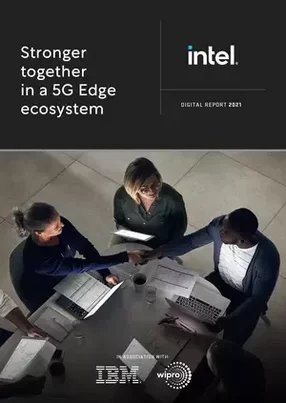IBM, Intel and Wipro: Stronger together in a 5G ecosystem
More organisations across multiple industries are understanding the importance of collaboration when it comes to technology. These digital ecosystems are naturally stronger than their individual parts, and you can take that to a whole new level when those partners include the likes of Wipro, Intel and IBM. However, with 75% of enterprise workloads still not migrated to the cloud, and executives expecting a 20% increase in the prioritisation of cloud and AI technology in the next two years, a hybrid cloud approach is required. This represents a US$1 trillion market opportunity for IBM, its partners and their customers.
This is a time of enormous change and opportunity for 5G and edge computing, with exciting applications across everything from healthcare to retail, from driverless cars to autonomous mining. IBM, Intel and Wipro have joined forces to offer telcos and enterprise clients new revenue streams that simply did not previously exist.
“In an ecosystem that is somewhat fragmented and complicated, we rely on partners such as Wipro to deliver solutions and software to end customers utilising Intel technologies and also IBM hybrid cloud,” says Eric Levander, GM, Global Solutions & Scale, Network & Communications Sales, Intel.
“We provide components, building blocks. Very few end users can extract the value from a piece of silicon. It is when we work with the ecosystem that it comes to life. Without the ecosystem, our products just generate heat. That's why it is so crucial for us to drive the digital transformation for customers, to enable them to scale and innovate through partnerships that combine the best -in-class technology and deep industry experience.”
Levander, who has been with Intel for more than 23 years, says Intel and IBM deliver new capabilities to run workloads in any environment on any cloud. This broad ecosystem provides end users with innovation and freedom of choice – building solutions on open platforms such as Wipro. He also says that 5G Edge is a new way of delivering network-as-a-service for multiple industrial applications.
“How those come together is an ecosystem of ecosystems,” says Levander. “With 5G in place, you need to bring together these ecosystems and ensure that the solutions are commercially consumable, and that takes a bit of time, but we were seeing tremendous traction, especially in those mission-critical areas.”
Dr Evaristus Mainsah is GM, IBM Hybrid Cloud & Edge Ecosystem, and his team’s core focus is helping clients on their journey to digital transformation. In particular they focus on systems integrators looking to build solutions around IBM’s technology and ecosystem partners for cloud and telecommunications which includes edge computing.
“The ecosystem is core to IBM's growth strategy, so when our partners succeed, so do customers, and so do we,” says Mainsah. “When it comes to telco and edge, the need for the ecosystem based around a common platform is greater because of the intrinsic heterogeneous nature of those environments – often a plethora of different devices or the IT hardware software and services provided by different partners.
“IBM works with our partners providing resources including expertise to help them get to market faster and grow their businesses with our technology. Together we are creating shared value for customers and a shared vision for the future of hybrid cloud and AI, including use cases that take advantage of the opportunities provided by 5G and edge computing. So partners like Wipro and Intel – with their own technology and skills and expertise – are key to that ecosystem and the value that it creates for businesses.”
Mainsah says businesses are striving to become more and more digital, more data driven, moving more online, more contactless, and becoming more automated. This shift was well underway prior to the pandemic but has been accelerated leading to investments in data management and analytics, machine learning, and AI to enable better visibility and improve decision making.
Proving 5G’s value
Thomas Muller is CTO, Wipro Engineering Services. Wipro joined the IBM Edge Ecosystem in 2020 when it launched its 5G edge services solutions suite, designed to offer Wipro customers better data control, reduced costs, faster insights and actions, and more automated, secured operations.
“We are creating practically anything, from chip to cloud,” says Muller. “We build one of the latest generation chips for many of the main brands in the semi computer industry, including TSMC.
“We then have our software practices who create the embedded software for those systems to actually come to life. We create the application and product software on top of it, and then we take it to our respective customers across industries.”
One of the largest industries served by Wipro is networking and connectivity, with some of the latest products in 5G supported, created and designed by Wipro engineers for the leading brands.
When it comes to high tech, Wipro can also partnerships with the likes of Google, Microsoft, and Facebook.
When Muller took responsibility for 5G technologies in the engineering space at Wipro, the first challenge he set for his teams was to provide a use case that only 5G can deliver. And that turned out to be quite an exercise, because it was hard to find.
“While we talked about a lot of things like no latency, and VR, and AR and all kinds of fancy things, in reality, none of those use cases that were brought to me actually exhibited the characteristics that could not have been done with existing technologies if someone really wanted to,” he recalls. “We were basically at the point where the technology is searching for a problem, which would be unfair to 5G. To really show its strengths, we needed to look hard and find use cases that would actually leverage those capabilities under certain circumstances.”
Muller and his teams had to turn to the pinnacle of technological engineering – Formula One – to find a challenge stiff enough to test 5G’s capabilities and prove its business case. As he says, if there is no business case, even if the technology is super smart, there is no point in doing it. He also believes strongly that the importance of the ecosystem has grown significantly in the last few years.
“We have our own ecosystem initiative anchored at leadership level in Wipro,” says Muller. “We call it Ecosystem Next, where we work with strategic partners such as Intel and IBM, and a few more of the major cloud hyperscalers.
“Intel is a key partner to enable us to drive 5G adoption worldwide with communication service providers. Intel technology is at the heart of disaggregated 5G solutions, and Intel has done a tremendous job with their technologies, not just the processors, but also their accelerator technologies. The whole software ecosystem for disaggregated 4G and 5G software would not exist without Intel having started their innovation leadership in their investments in this space.
“IBM, as a partner, is tremendously important for us to drive the softwarisation of digital products. IBM has, in partnership with Red Hat, a tremendous set of open source-based technologies that help us disaggregate previously monolithically integrated black box solutions. That can be networking products, that can be medical devices, that can be automotive product technologies.
“Technologies that IBM makes available to us, be it the Red Hat platforms, looking at OpenShift, they allow us to create a manageable software ecosystem that we can roll out from very tiny platforms, from Raspberry Pi-sized computers, IoT-size computers, all the way across to very scalable hyper converged infrastructures in edge and central implementations. And that's where IBM's key value for us comes in – as an infrastructure partner with Red Hat.”
Muller also adds how Wipro is using IBM software tools across its engineering organisations – IBM's lifecycle management tools help Wipro drive efficiencies in software engineering factories, using model-based design approaches and quality assurance.
5G’s bright future
The COVID-19 pandemic has made many organisations rethink their strategy – building for increased resilience and sustainability.
Nagaraju Cheemalamarri, General Manager and Business Leader, 5G and Emerging networks, has been at Wipro since 1994, and believes the pandemic has transformed how organisations operate – opening a huge opportunity for 5G and edge computing.
“Edge computing is a crucial element in terms of developing the next generation of digital services,” says Cheemalamarri, “and it's also not new – it has been prevalent in various forms already.
“5G actually opened up a new range of opportunities and possibilities from the edge perspective. Enterprise 5G and also the edge compute and MEC market will be a growth engine for us in the next two to three years, and the main drivers here will be the simplification and also automation of all these deployments. We are also making very aggressive investments into cloud.
We created ready to service pre-integrated reference stacks like BoundaryLess Universal Edge (BLUE) and 5G Edge Services Solution Suite so that customer needs are addressed providing time to market advantage.
Our BLUE framework offering has ready to service, pre-integrated IBM stack components such as IBM Edge Application Manager, IBM Cloud Pak for Network Automation, Data platform and Watson AIOps which is included in our offerings.
We leverage Intel on the software front using OpenNESS which is their open network, edge services software platform. And on the hardware front, we use varied Intel hardware, such as integrated GPUs, core and Intel Atom. We are integrating our Edge lifecycle management platform with Intel Smart Edge software stack, which can provide integrated and intelligent connectivity edge offerings.
Intel’s Eric Levander says when it comes to future-proofing, companies have to ensure their investment is sustainable and they don’t “build themselves into a corner”.
“Going forward, open solutions with broad ecosystem support is the high-level answer to aim for,” he says. “The broad ecosystem always wins over time and that is the best investment protection for enterprise today.”
Levander also points out that when it comes to precious data, it is all extracted from or touches Intel architecture at some stage, so it’s incredibly important that Intel builds in security features on silicon, on the platforms that are supported by the ecosystem.
“I don't think we can underestimate the impact of the data and the data revolution that is happening for us and for our customers,” says Levander. “Our job is to enable other ecosystems and new business models as part of the data revolution.”
IBM’s Evaristus Mainsah concurs and concludes that ecosystems fuel platforms. IBM Cloud for Telecommunications is built on an open architecture, so a large ecosystem of partners can enhance it with their own solutions in addition to providing services for it.
“The combined strength of IBM, and our partners, will create a large hybrid cloud ecosystem that can help operators meet three strategic industry imperatives: attracting and retaining subscribers; increasing investment effectiveness while driving down operational costs; and creating new, monetisable digital services,” says Mainsah.
Welcome to the ecosystem era.



